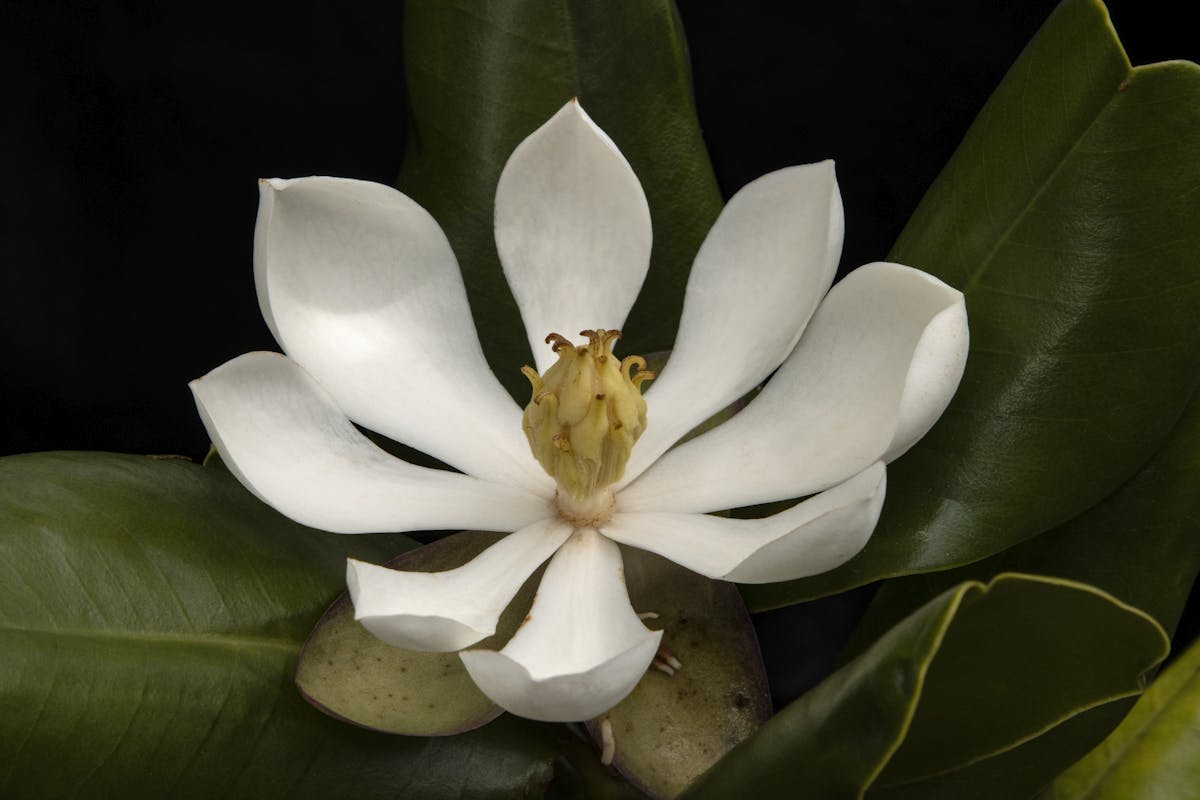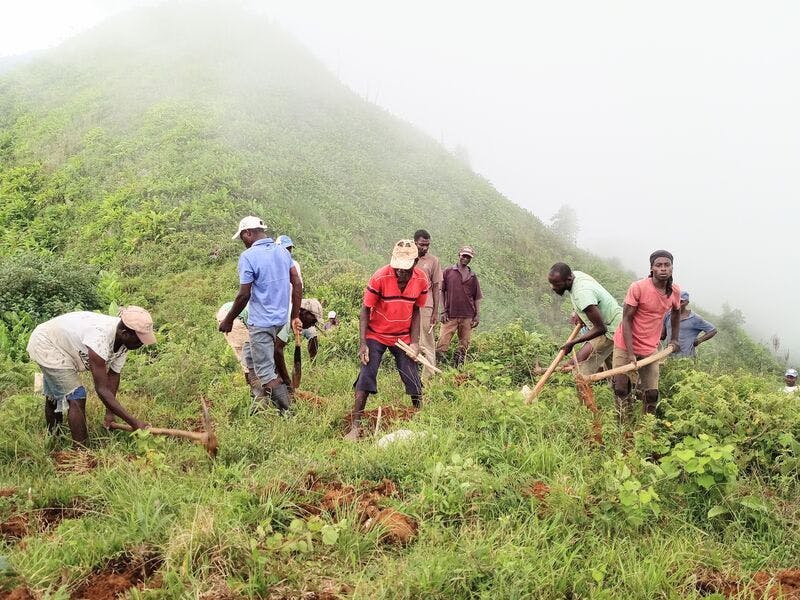 BACK TO NEWS
BACK TO NEWSHope and healing in Haiti’s Grand Bois National Park
Local community members hired by Haiti National Trust help restore the country’s rapidly shrinking forests
By Milo Putnam on October 26, 2022 
In a country where less than 1% of its original forests remain, local communities are leading a successful rewilding effort in Haiti’s Grand Bois National Park--one that is not only helping restore a critical wild land, but that is bringing hope to Haiti as the country continues to overcome turmoil.
“After God, it’s the park. I feel healthier living up here in the park, this place provides me food to eat and gives me medicine,” says Clairzida Dasney, a resident of Sevré, a village in the buffer zone of Grand Bois National Park. “This park is my pharmacy. I am happy and healthy here thanks to its forests.”
Dasney is one of thousands of Haitians who depend on Grand Bois National Park for survival. But now, thanks to a project led by Re:wild close partner Haiti National Trust, the park is relying on Dasney and other community members for their help in ensuring its future. In the same way that local communities are working to transform the park, the park is transforming lives, demonstrating how nature-based solutions can be economically beneficial.
A mutual relationship
Despite Haiti’s rich history and diverse cultures, many agree that the country is a devastating example of what the effects of deforestation and climate change look like. From diminishing agricultural harvests to life-threatening hurricanes and landslides, Haitians like Dasney are left more vulnerable year after year. As the poorest country in the western hemisphere, Haiti makes a clear connection between the global human welfare crisis and ecological destruction.
“Haiti is on the brink of losing all of its forests,” says Anne-Isabelle Bonifassi, executive director of Haiti National Trust. “Our country has one of the fastest rates of deforestation compared to any other country in the world. But we remain determined to prevent ecological collapse for Haiti’s people and our cherished landscapes.”
Earlier this year, in part to address this devastation, Haiti National Trust (HNT) launched a new initiative to rewild one of the country’s most treasured national parks, Grand Bois National Park, which is located in the Massif de la Hotte mountain range in southeastern Haiti. The park is classified as a Key Biodiversity Area, playing a critical role in the persistence of life on Earth. This mountain range is both a vital source of water and a hotspot for biodiversity as one of the last remaining cloud forests in Haiti. HNT has begun the work to plant over 60,000 native palms, trees, and shrubs each year. Only five months in, this work has surpassed the halfway point of this year’s goal with over 30,000 plants planted.
But the success of the work depends entirely on the participation and support of local communities. In turn, this project has brought economic value to local community members, who have now become invested in the restoration work in part because they are helping lead it.
“I help grow native seedlings from the nursery at my house inside the park,” says Dasney. “Every day I tend these plants to ensure they are healthy, even learning how to mix the soil for the seeds to grow stronger. I love supporting our reforestation activities. When there are trees, there is water, there is life.”
Dasney’s home not only acts as a sanctuary for seedlings to grow before being replanted within their wild ecosystems, but she also opens her home to team members. Scientists with HNT setting out into Grand Bois regularly rest at her house. Dasney has a contract with HNT to compensate her for these visitors that she graciously hosts, but according to Bonifassi, she actually often refuses any payment and emphasizes her desire to support the park and create a future for Haiti’s children. Without any children of her own, Dasney is determined that her country’s next generation has thriving wild places like Grand Bois to depend on and enjoy.
Revaluing Haiti’s forests
More than 12 million people live in the tiny nation of Haiti, many of them depending on wood charcoal for fuel and subsistence farming for food. As the country’s lowlands were deforested as a result, people turned to forests in higher mountain elevations to support their livelihoods. Haiti’s deforestation is primarily driven by small-scale farming and charcoal production, which involves harvesting wood and heating it to remove water and volatile compounds.
In the case of Elizé Roberty, a lifelong resident of Sevré, his father used to work deep in the once thriving forest when he was a kid. Now Roberty is helping to reforest Grand Bois. As Roberty grew older, he saw firsthand the decline of these forests, and is now determined to play a role in restoring them to how they once were.
“I want the park to be like it was when I was a kid, it was lush and dense with plants,” says Roberty, who has received training from HNT to support these rewilding efforts. ”I have hope now because it’s working. I think our reforestation activities will help everyone, especially the people in my village. While I might not have much to provide my children, I can help protect the forest so they can one day benefit from a rich land.”
Individuals living within the park’s buffer zone have the greatest knowledge of the land and are hired and trained by HNT to support rewilding efforts. By working with locals, an exchange of knowledge helps reinforce the importance of the work they’re doing in protecting and restoring the park. Dozens of community members have received training from HNT and are employed each day to care for seedlings in the HNT nurseries, help maintain park pathways, and aid planting initiatives within the park while removing invasive species.
This includes Jean Joslin, a resident of Sevré who was born and raised surrounded by Grand Bois’ once towering forests. Joslin is HNT’s first full-time park ranger, tasked with patrolling the park, and ensuring its protection. During his lifetime, he’s experienced Haiti’s devastating natural disasters and lived through ongoing economic and political turmoil. He’s struggled to find work to help support his family, ensuring that his five children are taken care of. With training from HNT, Joslin has been able to play a role in restoring his country but most importantly in helping provide for his family, he says.
“The training has helped me, now I know how to plant trees, how to place seeds in a nursery, and cultivate cuttings,” Joslin says. “Now I see them growing and thriving. Thanks to the teachings I received from this project, I have the skills to use what I know in planting crops to feed my family. I am so thankful for this reforestation project. I say let’s keep working and never give up!”
Growing Haiti’s future
HNT intends to continue restoration and rewilding efforts in Grand Bois National Park for as long as possible, even expanding their work to support agroforestry practices in the park’s buffer zone. By working with farmers in developing sustainable agricultural practices, these initiatives will help protect the remaining forests, restore what has been deforested, and allow communities to plant their own food and generate alternative sources of revenue.
In the future HNT hopes to replicate this work in other protected areas throughout the country alongside other local communities helping to rewild and heal an entire nation.
“I wish to always do this work for protecting the park,” says Dasney. “My community loves our park and we want to protect it. I sincerely hope our work never ends.”
About the author
Milo Putnam
Milo is Re:wild's communications specialist working with our partners to share their stories in protecting and restoring the wild. With over a decade of natural resource interpretation and environmental education experience he lives to spark connections between people and wildlife. Milo loves to travel with his husband and is passionate about supporting ethical wildlife tourism.
Related News and Other Stories

By Milo Putnam on August 01, 2022
Rediscovered magnolia tree spurs hope in Haiti, where just 1 percent of the country's original forests remain
READ MORE
By Milo Putnam on October 26, 2022
